|
|
 |
 |
| Temple-based Ritual |
|
|
Picture yourself on a street in Delhi, or in a neighborhood in Queens, New York. Wander long enough, and you'll find yourself at a Hindu temple, constructed and cared for by the local community, often with transnational connections and support. Let us enter this sacred space. Look behind you; a worshiper has also entered. How does this worshiper experience and interact with the temple and the images housed within it?
At the door, shoes are left to the side: the impurities of the outside world cannot be brought into the house of God. The worshiper approaches the deity, who is traditionally enclosed in a central shrine but may be found in a modern temple on a platform alongside many other deities (Figure 1). Her behavior now will vary according to devotional affiliation and personal disposition. She may reach up and ring the bell that awakens the deity and announces her presence, commencing the act of worship. She will join her hands together in respectful greeting, and engage in a visual exchange (darshan) with the deity, who is represented or embodied in the image, and who is usually beautifully adorned (Figure 2). The priest in attendance may offer to pour water into her hands, a common practice in temples dedicated to Vishnu; if so, she will sprinkle some upon her head and take a sip. This is a form of prasad, which literally means "grace" -- material infused with the presence of the deity and shared with devotees. One may find this basic interaction repeated with infinite permutations and meanings in any temple or roadside shrine (Figure 3).
Puja is the term used for the actions of worship described above, which constitute a basic form of interaction between a worshiper and the deity enshrined in a temple. Individual interaction is common in temples, as most do not have formal congregational services outside of scheduled, priest-led pujas and occasional festivals. Temple celebrations or gatherings will often include the singing of songs in praise of the deity or partial or complete recitation of a sacred text. Two popular texts are the Bhagavata Purana, a Sanskrit text that describes the incarnations of the great God Vishnu and -- in Hindi-speaking areas -- the Ramcharitmanas, which relates the adventures of one of Vishnu's incarnations, the king Rama. Festivals might also include all-night singing and dancing, or large-scale processions and fairs in which a movable image of the deity is brought out for public display (Figure 4). Special observances can occur regularly, such as on a particular day of the week -- Tuesday, for example, is sacred to the Goddess Mariamman in the south and to Hanuman and others in the north -- or yearly, like the pan-Indian Shivratri festival that takes place in February or March.
The ritual specialists who preside in temples are often, but not always, Brahmins. Although caste distinctions vary widely across South Asia, Brahmins are generally responsible for conducting rituals in temples that adhere to traditional caste hierarchies, while non-Brahmin priests officiate at local village shrines and temples that are not under brahminical ritual control (Figure 5). Brahmins are members of the highest of the four traditional hereditary occupational castes that are found in varying numbers throughout the subcontinent. The other castes are the Kshatriyas (warriors/rulers), Vaisyas (merchants), and Shudras (servants, artisans, etc.). In some places, such as at the Jagannath temple in Orissa, Brahmin priests share responsibilities with lower-caste ritual specialists at defined times, for particular ritual observances (Figure 6).
Daily, scheduled pujas play a fundamental role in the life of a temple and in the lives of its images. More elaborate ceremonies are held in large temples and at festival times, while smaller temples often have greatly reduced ritual schedules and services (Figure 7). Still, there is a core of practices and rites performed in most Hindu devotional contexts. These practices generally follow the prescriptions recorded in the Agamas and Tantras, texts composed in the first millennium and at the beginning of the second, which define aspects of both domestic and temple ritual. Such rituals take place at particular points in the day, following a schedule that mirrors the rhythms that govern the human day -- awakening, lunch, afternoon rest, evening meal, retirement for the night -- and the natural junctures of the day in the morning, afternoon, and evening.
Along with other texts, the Agamas and Tantras identify sixteen core elements (called upachara) of a puja ceremony; not all are performed on every occasion in every temple, however -- even at important and wealthy temples like the temple of Minakshi, which is part of a large temple complex in Madurai (Figure 8). Preliminary rituals, featuring the elephant-headed God Ganesha (often worshiped at the initiation of activities or undertakings to bring about a fruitful result) and the statement of an intention to undertake the ritual, are common. As in home worship, the sixteen upachara fall into four categories: (1) the deity is invoked in the image; (2) water is offered for washing; (3) the image is literally bathed, dressed (Figure 2), adorned, shown incense and a lamp (in a ritual known as arati), and offered food; and (4) the image is shown respect and bid farewell. The arati, which consists of the waving of a lamp in front of the deity, is a powerful aspect of the ritual, and is seldom excluded. As a symbol of the simultaneous embodiment and transcendence of the divinity, and a focal point for the worshiper, the flame directs energy and wipes away distinctions between the worshiper and the worshiped.
Distinctions between worshiper and worshiped are also obliterated through the consumption of prasad, the "grace" of God. Prasad can consist of ash and powder in temples sacred to Shiva, or of water, as is common in temples dedicated to Vishnu. The food offered by the priest to God and then distributed to worshipers is also prasad, and through all of these means the materials infused with the divinity of God in the puja service are infused into the worshiper physically. In general, the deities so honored do not require the ministrations they receive; these are instead a manifestation of the human desire to honor the God and the human need to interact directly with him or her. Some Gods, particularly village and regional Gods (who might or might not be associated with the "great Gods" of the pan-Indian Puranic tradition, Shiva and Vishnu), can be cajoled quite successfully by the offerings made to them.
Offerings can take a variety of forms (Figure 9), but with a major distinction between those that are vegetarian and those that are not: although disapproved of by some, animal sacrifice does continue in certain temples and for particular deities, such as some forms of the Goddess. In fact, offering food to the Gods is essential to the act of worship, fundamentally capturing the goal of treating the deity as an honored guest. Beyond this goal, according to many traditions worship requires the identification of the worshiper with the worshiped, and thus the divinization of the devotee within the process of worship. Through the temple rituals, the worshiper not only interacts visually with the God and partakes of his or her blessings, but can fully experience and become one with God.
< previous next >
Top |
|
 |
 |
| Click for details |
 |
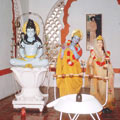 |
 |
Fig. 1
|
 |
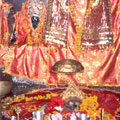 |
 |
Fig. 2
|
 |
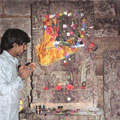 |
 |
Fig. 3
|
 |
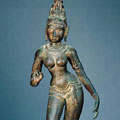 |
 |
Fig. 4
|
 |
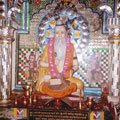 |
 |
Fig. 5
|
 |
 |
 |
Fig. 6
|
 |
 |
 |
Fig. 7
|
 |
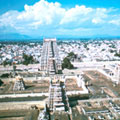 |
 |
Fig. 8
|
 |
 |
 |
Fig. 9
|
 |
|
 |


